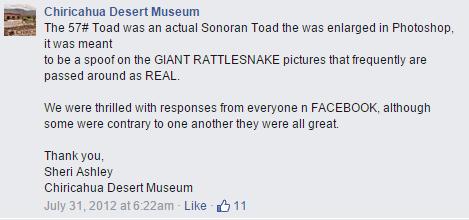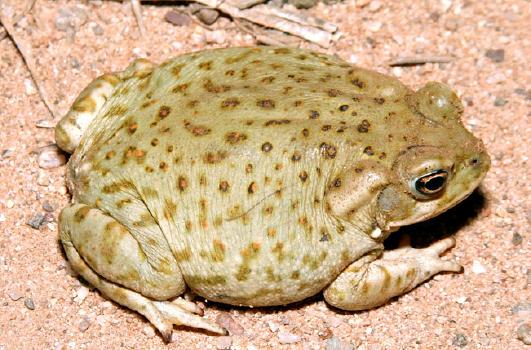

Unraveling The Mystery Of The 57-Pound Sonoran Desert Toad
In the quiet border town of Rodeo, New Mexico, an unusual tale has captivated the local community and sparked curiosity across the internet. Residents have reported a series of mysterious pet disappearances, leading to speculation about a menacing predator. As rumors circulated, a dramatic twist emerged with the discovery of a seemingly monstrous Sonoran Desert Toad weighing in at a staggering 57 pounds. This startling revelation has prompted both bewilderment and outrage, leaving many to wonder: could this toad truly be responsible for the missing pets?
As we delve into this fascinating story, we'll explore the origins of the photograph that ignited these claims, the nature of the Sonoran Desert Toad, and the truth behind the viral image. The claim, which has been shared widely, raises questions about the nature of reality in the age of digital media and how easily misinformation can spread. Join us as we uncover the truth behind this peculiar and captivating tale.
This exploration not only highlights the quirks of wildlife behavior but also serves as a reminder of the importance of fact-checking before accepting sensational claims. With the help of expert opinions and factual context, we aim to clarify the facts surrounding this oversized amphibian and its alleged impact on the local pet population.
What You Will Learn
- The background of the Sonoran Desert Toad and its typical size.
- Details about the viral photograph and its implications.
- The community's reaction to the supposed pet-eating toad.
- The significance of fact-checking in the digital age.
The Tale of the Missing Pets
For nearly two months, families in and around Rodeo, NM, have been dealing with the distressing situation of their small pets disappearing without a trace. Initially, a mountain lion was suspected of causing the chaos among the community's pet population. However, everything changed when a photo emerged featuring a gigantic Sonoran Desert Toad found near the Chiricahua Desert Museum. This creature, measuring an unprecedented 57 pounds, led residents to suspect that it may be the culprit behind their missing pets.
In an astonishing twist, the toad reportedly dispensed around two gallons of urine during its capture, adding to the bizarre nature of the discovery. While the Sonoran Desert Toad is known to be one of the largest native toads in North America, it typically weighs no more than 1.5 pounds and measures about 7.5 inches in length. This stark contrast has drawn skepticism about the authenticity of the claims surrounding the photograph.
Fact-Checking the Viral Image
On July 24, 2012, the Chiricahua Desert Museum posted the controversial photo to their Facebook page, claiming it depicted a 57-pound Sonoran Desert Toad responsible for preying on local pets. The museum's authoritative image led many to believe the story was genuine. However, a week later, the museum admitted that the photograph was a Photoshopped hoax, intended to parody the numerous "giant rattlesnake" photos circulating online.
This revelation serves as a crucial lesson in the digital age. With the speed at which information spreads, it's essential to verify claims before accepting them as truth. The online community must be vigilant, as sensational stories can easily lead to misinformation and panic.

The Sonoran Desert Toad, while real and found in regions of Arizona and New Mexico, is not the terrifying creature depicted in the viral photograph. Typically, this toad measures only about 7 inches in length, showcasing the contrast between reality and the exaggerated claims made by the hoax.

Understanding the Sonoran Desert Toad
The Sonoran Desert Toad, scientifically known as Bufo alvarius, is a remarkable creature indigenous to the southwestern United States and northern Mexico. As one of the largest toads in North America, it plays an essential role in the desert ecosystem. It is important to note that while these toads can be large, they do not reach the sizes depicted in the viral hoax.
Typically, the Sonoran Desert Toad can be easily held in hand, with its notable features including smooth, moist skin and a distinctive coloration that helps it blend into its natural surroundings. Understanding the species helps dispel myths and promotes awareness about the natural world.
| Attribute | Details |
|---|---|
| Scientific Name | Bufo alvarius |
| Common Size | About 7 inches in length |
| Habitat | Southwestern United States and Northern Mexico |
| Diet | Insects and small invertebrates |
In conclusion, the tale of the 57-pound Sonoran Desert Toad serves as a fascinating reminder of the power of misinformation and the importance of verifying facts before jumping to conclusions. While the story may have entertained and intrigued many, it also highlights the need for critical thinking in our digital age.
As we navigate through various claims online, let us remember to approach sensational stories with caution and seek the truth behind the headlines.
The Truth Behind Coca-Cola: The Acids That Make It Harmful To Drink
The Truth Behind The Eight Rainbows Over Lehigh, Pennsylvania
Apple's Integration Of ChatGPT: What You Need To Know
